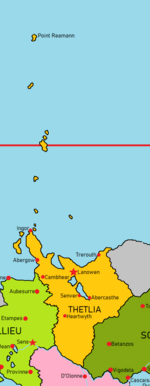Thetlia: Difference between revisions
No edit summary |
Tag: Undo |
||
| Line 3: | Line 3: | ||
|conventional_long_name = Kingdom of Thetlia | |conventional_long_name = Kingdom of Thetlia | ||
|common_name = Thetlia | |common_name = Thetlia | ||
|image_flag = | |image_flag = Thetlia Flag ver 2.png | ||
|alt_flag = | |alt_flag = | ||
|national_motto = | |national_motto = | ||
Revision as of 19:32, 6 July 2024
Kingdom of Thetlia Tiwnas Ceirú | |
|---|---|
Error creating thumbnail: File with dimensions greater than 12.5 MP Flag | |
 | |
| Capital | Lanowen |
| Official languages | Thetlian (Ceirú) |
| Recognised national languages | English |
| Government | Parliamentary constitutional monarchy |
• Monarch | John I |
| Estevan Manley | |
| Population | |
• 2023 estimate | 26,039,443 |
| Date format | dd-mm-yyyy |
Thetlia, officially the Kingdom of Thetlia (Tiwnas Ceirú) is a country on the north-west coast of Euronia, facing the Northern Ocean. Thetlia is bordered by Allieu to the west, Sontre to the east and Noravia to the south. The capital and largest city is Lanowen, other major cities include Charleith, Abercasthe and Cambhear. Thetlia’s official language is Thetlian, known as Ceirú, but English is also a recognised language. Ceirú is widely spoken by Thetlians, who make up the majority of the population. Other groups are mainly comprised of people from neighbouring nations concentrated in the border cities. Thetlia's diverse geography includes plains, forests, mountains, as well as two major lakes in the north that serve as historic trade and population hubs. Thetlia also owns the Feid Christina Islands, which makes Thetlia the northernmost nation in Euronia, and 5th northernmost in the world.
Thetlia is constitutional monarchy, the reigning monarch is the head of state, whilst a Prime Minister is selected by the winning party following an election. The reigning monarch is King John I, and the current Prime Minister is Estevan Manley. Direct democracy, including popular initiatives and public referendums, make up a large part of the Thetlian political process, allowing Thetlians to enjoy high levels of political freedom and civil rights such as the right to bear arms.
Etymology
Thetlia is not the native name of the country, the origin of Thetlia comes from the old city of Thetlia, which was the first major settlement south of the Thetlian mountain range. The city served as the first point of contact between the peoples inhabiting the area. When questioned about their origin, the Ceirú would often respond with the name "Thetlia", giving rise to the belief that the term referred to the entirety of the country.
The name Ceirú comes from the name of the inhabitants that migrated to Thetlia, hence the name Tiwnas Ceirú meaning Kingdom of (the) Ceirú.
History
Prehistory
Early Kingdoms of Thetlia
Gladysynthian Rule
20th Century
1904 Revolution and Thetlian Independence
The 1904 revolution was an insurrection fought between the Thetlian people and the Gladysynthian empire, lasting from the 5th of May to the 10th of November 1904, which ended when a treaty was signed between the two parties, granting independence to the Kingdom of Thetlia.
Resentment towards the Gladysynthian Empire prior to the 1904 revolt was fueled by multiple factors including recent famines and economic hardships that affected the region, as well as an overall suppression of Thetlian identity. The pivotal event that is said to start the revolution was the attempted execution of Thetlian rebels and a bombing that targeted the Gladysynthian headquarters in the city of Lanowen, by which fighting broke out soon thereafter. This act against the empire sparked a widespread uprising across the country aimed at overthrowing Gladysynthian rule. The attempted execution and the bombing served as powerful symbols of resistance, rallying the Thetlians to secure independence from the Gladysynthian Empire.
Following the fighting in Lanowen, uprisings swiftly spread across Thetlia, encompassing major cities, smaller urban centres, and countryside areas with limited government presence. Uprisings in the Northern regions of Thetlia had greater success owing to the natural barrier provided by the mountain range that separated the country. Rebels in Heartwyth strategically blockaded the primary road connecting the north and south, effectively obstructing Gladysynthian troops' access and impeding their resupply effort, significantly bolstering the rebels' advances in the north.
Conversely, the mountain range posed a considerable challenge to rebels in southern Thetlia, where the Gladysynthian Empire had a wide access region, leading to swift suppression of uprisings in Chyleith and Tanfach. Rebels in the city of Thetlia managed to escape through the mountain pass, joining the forces in Heartwyth.
By October, the Thetlian forces had successfully repelled the Gladysynthians from the North. The rugged terrain and the defensive positions adopted by the Thetlians resulted in a stalemate. Internal troubles within Gladysynthia further complicated matters, eventually leading to a ceasefire agreement.
On November 10th, 1904, the Thetlian Declaration of Independence was signed, granting independence to the Kingdom of Thetlia, whilst the Southern Territories remained under the sovereignty of the Gladysynthian Empire.
